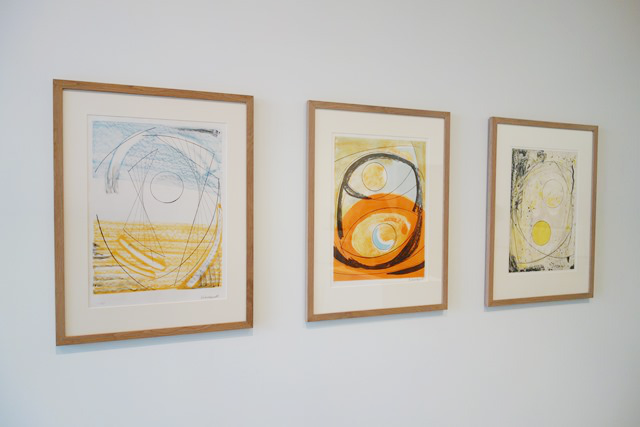
Buying original prints offers a wonderful way to enjoy affordable works of art by favourite artists. The rich variety of tones and textures that can be achieved with printmaking techniques ranging from etchings and linocuts to silk screen prints and lithographs also provides plenty of interest for the keen collector. Moreover, the value of rarer, sought-after prints has been rising and can represent a canny investment.
It makes sense, therefore, to take into consideration some ways of caring for your prints. Museums rarely display more than a small proportion of their print collections at any one time, since the best way to preserve works of art on paper is by keeping them in the dark, in archival boxes, within an environment where relative humidity and temperature can be controlled. A collector may also want to protect their prints by keeping them away from the potentially damaging effects of light. For most of us though, we want to enjoy the print and display it. The following steps can help to give it the best possible protection.
• Handling – Try to handle the print as little as possible and, when you do, always make sure your hands are clean and that you support the print fully, as the paper can pick up dirt or crease easily. I am always astonished when collectors proudly show me their valuable map or print before casually picking it up in one hand from the corner, risking putting permanent creases in the paper. If it is not going in a frame immediately then wrapping it with some acid-free tissue will help keep dust off it. Although large prints are often sent rolled, try to avoid leaving them rolled for any length of time.
• Choosing a framer – If you want to display your print then use a framer who is Fine Art Trade Guild (FATG) Commended or Certified. They will usually have a sticker with this information in their window. If it is a valuable print then a paper conservator will be able to advise on a framer who has taken the FATG Advanced Conservation Framing certificate or undertake the work themselves.
• Mounting – Any mount board used, both in front of and behind the print, should be acid-free and not contain any un-purified wood-pulp. Mounts that have a brown core are usually cheap, acidic, wood-pulp which can cause staining of the paper in a short space of time. Conservation board refers to chemically-purified wood-pulp which is acid-free. A better board still is Museum board which is made from 100% cotton fibre.
• Hinging – Paper will undergo slight, natural dimensional changes so should never be stuck down completely to a support but attached with small tabs of tape or ‘hinges’. A good framer will use white, acid-free, gummed tape to hinge prints into their mounts. Don’t be afraid to check with the framer that they will not use Sellotape, masking tape or other non-archival pressure-sensitive tapes. Their adhesives rapidly stain paper and will eventually fail. No adhesive should be used that is not easily reversed. Paper conservators make ‘hinges’ from high-quality Japanese paper and apply them with traditional wheat starch paste.
• Glass – There is now a wide range of glazing options that can both protect and enhance the appearance of the picture. Filtering out ultraviolet does not stop fading of light sensitive colours altogether but it does cut out the most harmful wavelengths. Digital prints can be more susceptible to fading than traditional printing inks, with laser prints more fugitive than inkjet, Giclée prints. Tru-Vue®, Conservation Clear® glass is an affordable option that most framers should be able to supply. More expensive but worth the investment for some artworks are glazing products that are Water-White® and Low-Reflect® making the glazing incredibly discreet.
• Acrylic – Acrylic can be the safer option for glazing large frames, with dimensions larger than one metre or for making stylish, contemporary box frames. VA Grade Perspex® will also filter out ultraviolet. Whether using glass or acrylic, always ensure that a mount or spacer will provide sufficient air-gap between the inside of the glazing and the print. Not only does this ensure inks do not adhere to the glazing, it also reduces the risk of moisture damage which can lead to mildew staining or brown spots, known as ‘foxing’, developing in the paper.
• Backing a frame – Frame backboards can be hardboard, MDF, corrugated acid-free boards or fluted polypropylene such as Correx. These are all suitable but a conservation framer will also add a sheet of clear polyester, called Melinex®, or aluminium foil that serves as a moisture barrier between the mount and the backboard. A good, simple trick is to get the framer to add felt pads (I use slices from corks) to the lower corners on the back of the frame. This holds the frame a little off the wall and creates an air-gap which can help prevent damage from damp or mould.
• Hanging – Finally hang and enjoy your print. Try to avoid hanging valuable artworks above radiators or on a chimney breast where there will be extremes of temperature or on walls where they may be subjected to direct sunlight during the day. If you do not feel confident hanging a heavy or large frame there are local services who will undertake this for you such as HangMyArt or JPAArtServices .
If you would like further advice on restoration, storage, mounting or framing of your prints, drawings and watercolours then you can contact Richard at Artworks Conservation in Harrogate on 01765 676600 or email info@artworksconservation.co.uk
Richard will also be at The Hepworth Wakefield Print Fair at the Watermark Gallery stand on March 5th and 6th





